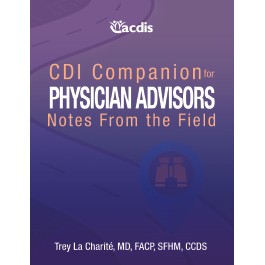Book Excerpt: The “organ system” approach to documentation

Advisors: Notes from the Field
By Trey La Charité, MD, FACP, SFHM, CCDS
There are few things more frustrating than the “organ system” approach to medical record documentation. Unfortunately, coders cannot code “acute respiratory failure” if all the physician writes is “respiratory system, continue on ventilator.”
In the CDI world, no diagnoses in the chart means no code assignments. There are no ICD-10 codes for “respiratory system,” “cardiovascular system,” “heme,” “neuro,” etc. They simply don’t exist. Physicians must give specific diagnoses if they want to receive credit for the work they perform and for the hospital to obtain reimbursement.
When I started as our CDI physician advisor, the organ system documentation approach was rampant, especially in the intensive care unit (ICU). I did my best to stamp out this documentation pattern. In my opinion, this is the most damaging documentation pattern possible for any physician’s or hospital’s publicly reported performance data, because it tells the readers absolutely nothing.
My solution was to take examples of lengthy, highly detailed ICU progress notes to our medical staff and show what coders were able to code. When all you can code from a three-page progress note is “thrombocytopenia” because that is the only diagnosis given anywhere in the note, they seem to get the message.
Recently, due to the arrival of new medical staff at my facility, I have witnessed a resurgence of this documentation pattern. However, while the assessment and plan sections of these provider’s notes are organized by organ system, the individual diagnoses needed for coding purposes to tell how sick a patient actually is are also meticulously listed.
For example, in a patient admitted with sepsis due to pneumonia, there might be a “respiratory” section. However, listed under that subheading is “pneumonia – continue current ABX. Cultures pending,” “acute respiratory failure – maintain current vent settings,” and “ARDS – oxygenation improving.”
Likewise, in a patient admitted for a stroke to our ICU, there might be a “neuro” section which then sequentially lists “acute left MCA territory stroke with intraparenchymal hemorrhagic conversion,” “brain compression with left to right shift,” and “hydrocephalus – continue mannitol and hyperosmolar therapy.”
While the scope and detail of this documentation certainly provides a complete picture of these patients’ clinical situations, I also believe it represents double documentation. However, I have not intervened as this hybrid pattern between the organ system approach and the diagnosis-specific approach to documentation as this practice seems to be working well for both the provider and the coder.
Editor’s note: This excerpt was taken from the CDI Companion for Physician Advisors: Notes from the Field.
